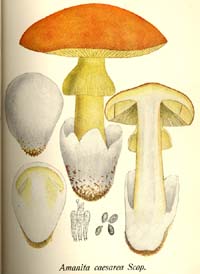Amanita fulva
 Key to Gilled Mushrooms Key
Key to Gilled Mushrooms KeyThis is a key to gilled mushrooms, that is, mushrooms having a definite cap with a fertile surface consisting of gills. The fruiting body usually also has a stem, although that may be lateral or absent (usually, then, the mushroom is growing from wood). You can use this key to identify mushrooms that you find.
 Agaricales Order
Agaricales OrderFruiting body containing fibers (usually in the stalk)
 Amanita Genus
Amanita GenusFruiting body having a combination of some of the following characteristics:
Stalk growing out of a cup of cottony tissue called a volva (all white-spored mushrooms with a volva go here)
Cap with scattered patches or flakes of the same sort of tissue as the volva (see second picture), easily peeled off
Annulus (skirt-like ring on stalk)
 Vaginatae Section
Vaginatae SectionCap margin distinctly striate in maturity
Either (most commonly) annulus absent and colors brown or grey, or
(rarely) annulus present and colors bright: red, orange or yellow
Volva sack-like in some species, in others clamped tightly to the stem, leaving traces in bands of color on the stalk
 Vaginatae SubSection
Vaginatae SubSectionCap usually some shade of brown or gray, occasionally white
Annulus absent, but there may be strangulated zones on the stem
Universal veil material generally not present (or only occasionally) on the cap
Volva sac-like, or clamped tightly to the stem
Larger Vaginatae StirpCap more than 1 1/2" across at maturity
Basidia mostly four-sterigmate
Here are the characters that distinguish this species from the others in its group. For its more general characters, see higher up on the page.
If there's just a few words or a microscopic feature here, a more thorough description can be found above.

Diagnosis
Microscropic Characters
Comments
When I first wrote this entry, I wrote:
"The stipe of Amanita fulva is usually much paler than the ones in the picture - - these may actually be a different species
The volva on this species is supposed to be ample and saccate, but it seems to be fragile, close to the stem, and in practice it is often almost absent."
Since then, I've learned that Rod Tulloss doesn't consider any of our American "Amanita fulva"s to be the "real", European Amanita fulva. So I'll be putting up more accurate names and descriptions as soon as someone comes up with them






 Key to Gilled Mushrooms Key
Key to Gilled Mushrooms Key Agaricales Order
Agaricales Order Amanita Genus
Amanita Genus Vaginatae Section
Vaginatae Section Vaginatae SubSection
Vaginatae SubSection





